Q: Do carnivorous plants have pharmacological (medicinal) properties?
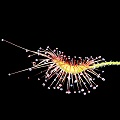
Drosera scorpioides
A: This question, while seemingly simple, is loaded with controversial topics.
However, let me break it down into five main components.
- Are carnivorous plants used in any "western medicines" or pharmaceuticals?
- Are there any untested or "fringe medicines" based on carnivorous plants?
- Are there historical medicinal uses of carnivorous plants?
- Are there herbal medicines based on carnivorous plants?
- Can I use carnivorous plants to get high?
Even this set of sub-questions is controversial. For example, when should a
drug be listed in category #1 vs. categories #2 or #3? Indeed, cultural imperialism
might be an issue
when trying to classify a compound used widely in India, but not registered in the USA.
Nonetheless, let
us try to wade through this briefly. (And do not forget, the "Dr."
in front of my name has nothing to do with medicine, either human or for other
animals.) Since this is an area in which emotions can run high, I will be particularly
fastidious on this page to cite all my relevent sources.
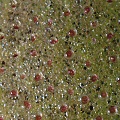
Pinguicula glands
1) Western medicines
Take a look at the veritable chemical factory in the close-up photograph of
the mucilaginous Pinguicula leaf to the right, and you could see why
people might think it is a place to find interesting potential drugs. However,
as far as I know, carnivorous plants have not
been used in mainstream medicines.
There is a compound ("Sarapin") based upon an extract of
Sarracenia purpurea that some claim can reduce neuromuscular
or neuralgic pain. However, this drug (and "prolotherapy",
its method of application) is not
quite mainstream medical practice (Leslie 2000).
For what it is worth, as of 2001 Aetna did not consider Sarapin
or prolotherapy legitimate enough to cover in its health plans
(see Anonymous, 2001). You can learn about this compound
at www.sarapin.com.
Some carnivorous plants such as Dionaea and Drosera contain
naphthoquinones, and these may have some therapeutic value. Unfortunately, these
chemicals have a high toxicity and this limits their curative values
(Hegnauer & Hegnauer 2001; Burrows & Tyrl 2001).
I am not a medical doctor, so do not e-mail me questions about this issue.
2) Untested or Fringe medicines
I hear of medicinal uses that do not appear to have been tested in
laboratory conditions for their effectiveness.
Lewis et al. (1977) note
that Drosera burmannii has been used in Hindu
medicine as a rubefacient (skin counter-irritant).
The tragedies of AIDS and cancer, and the impression that new medicines are not
being developed rapidly enough,
have forced many people to look to medicines that
have not passed the usual and substantial (some would say unnecessarily
obstructive, others would say merely wisely cautious) hurdles for pharmaceutical registration.
These formulations are sold
as "dietary supplements" or other such loose classifications. I know of
one compound called Carnivora which falls into this class. I have been
critical of Carnivora in the past because of the way a web site
used AIDS and cancer scare tactics to sell it. However, I have spoken to a
USA distributor and am convinced he is, fortunately, more ethical in his
sales approach. As to its efficacy, I am not qualified to make a
judgement--it is claimed to be good for all sorts of things, and if
nothing else would have value as an interesting placebo. (And studies indicate
that as much as 15-30% of the effectiveness of all
drugs are due to this powerful effect.)
Dionaea muscipula (Venus flytrap) is used in the formulation.
I have been told by the US distributor that all the plants used in making it are
artificially propagated, and are not field collected. I hope this is the case.
A recent study (Todorov et al. 2000) suggests that Carnivora may at most
have a "moderate
antiproliferative effectiveness on sensitive and resistant tumor cells
at relatively high concentrations and after a long time of exposure."
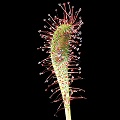
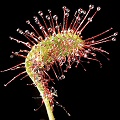
D. anglica
3) Historical uses
Old herbals list a number of uses for carnivorous plants.
Culpeper's Complete
Herbal (Nicholas Culpeper, 1616-1654) says of Drosera anglica:
Verhoek-Williams (1976) notes that in the middle ages, French sorcerers
would rub Drosera leaves on their skins on St. John's Eve (June 23) to become
indefatigable. The plants were said to glow at night (they don't, not
really), and could
be detected by the behavior of woodpeckers which used the plants to harden
their bills (they don't, not really). The sorcerers collected
the plants at midnight on St. John's Eve, and were supposed to walk backwards
as they did this to avoid being followed by the devil! Well, walking
backwards at night in a bog is not a smart thing, so I'm not surprised
this practice died out.
Charles Millspaugh, back in 1892, said that the
Native Americans of eastern North America used
Sarracenia purpurea subsp. venosa as a poultice against
small pox:
It should be noted, however, that contemporary tests of the same concoction were disastrous:
Millspaugh noted Rafinesque's claim that
Drosera juice is used "to destroy warts and corns; with
milk, for freckles and sunburns....Deemed pectoral in South America,
a sirup used in asthma." Millspaugh further noted that
many medical writers recommend its use in "different kinds" of coughs
related to "bronchial attacks, phthisis, and other diseases of the lungs."
Snyder (2005) has written a compelling and most interesting analysis of the historical uses of
Drosera by secret societies and alchemists, and suggests that Drosera dew
might have been an ingredient involved in the construction of the philosopher's stone, which
would impart immortality to the user. Has Snyder been reading "The DaVinci Code"?
4) Are there herbal medicines based on carnivorous plants?
OK, first let me say that I am not really sure at this point what constitutes
an "herbal medicine." After all, most non-herbal medicines have
their origins in plants (aspirin from willow trees, ephedrine from
Ephedra, morphine from Papaver somniferum).
I used to think that the difference was that conventional medicines were
extracts---and in particular
refined compounds packaged in pill form. Herbal medicines were in the form
of fresh or recently dried leaves, twigs, roots, etc. of some plant. A tea would
usually be made out of this botanical concoction, and would be drunk, inhaled,
or applied topically.
But now, when I visit
my local co-op and look in the herbal medicine section, I see row after row
of bottles containing---well---extracts in pill form!
The distinction is very blurry here.
I am a little bitter about herbal medicines, because their
advocates are ultimately
responsible for the illegal, unsustainable harvesting of rare species such
as American ginseng (Panax quinquefolius), threatening these plants with extinction.
My mild rant over (it's my FAQ and I can cry if I want to), I have seen
Drosera rotundifolia used in herbal cough medicines. Also,
Olin (1989) says that an extract of the plant is yet another of the diuretics
available to herbal medicine aficionados.
(Why do these people want to pee so much?)
Doing a quick google web search using good key words
(i.e. herbal medicine Drosera) I got lots of hits describing uses
for D. rotundifolia, D. intermedia, D. anglica, D. ramentacea.
You can do more searches using the other carnivorous plant genera yourself.
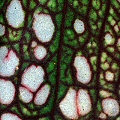
Duuuuuuude!
5) How to get stoned on carnivorous plants
Hah hah. If you are one of those dorks who e-mail me from time to time,
trying to use carnivorous plants to get high, you are really a twit.
No, you cannot get a euphoric or psychoactive effect from carnivorous plants.
However, I am here to try to help. I took a close-up photo of Sarracenia
leaf patterns (on the right). Kind of psycho, huh? Look at that for as long as
you can without blinking, then you will "see" the secret message about
the workings of the Universe. It works best if you stick your fingers in your
ears and keep your mouth open while you do it---this improves your
"Cosmic Receptivity".
Then send me lots of money to pay for the buzz.
For nonmedicinal, "ethnobotanical uses" of carnivorous plants, try
the next FAQ entry.
Page citations: Anonymous, 2001; Burrows & Tyrl, 2001;
Hegnauer, R. & Hegnauer, M. 2001; Leslie, M. 2000; Lewis, W.H. et al. 1977; Millspaugh, 1892; Olin, 1989;
Todorov, et al. 2000; Rice, B.A. 2006a; Schlauer, J. 2002 (personal communication); Snyder, I. 2005;
Verhoek-Williams, S. 1976.